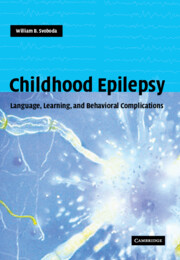Book contents
- Frontmatter
- Contents
- Preface
- Glossary
- 1 Looking ahead
- Part I Speech and language problems
- Part II Learning problems
- Part III Behavior problems
- 27 Mental health needs
- 28 Psychologic development
- 29 Seizure types and modifying factors
- 30 Overview: extrinsic factors
- 31 Behavior problems: general
- 32 Attention deficit disorders
- 33 Anxiety disorders
- 34 Mood disorders
- 35 Disruptive behavior problems
- 36 Psychoses of epilepsy
- 37 Non-epileptic events
- 38 Possible treatment issues
- 39 Helping with psychiatric problems
- 40 Epilog
- Index
- References
39 - Helping with psychiatric problems
from Part III - Behavior problems
Published online by Cambridge University Press: 26 October 2009
- Frontmatter
- Contents
- Preface
- Glossary
- 1 Looking ahead
- Part I Speech and language problems
- Part II Learning problems
- Part III Behavior problems
- 27 Mental health needs
- 28 Psychologic development
- 29 Seizure types and modifying factors
- 30 Overview: extrinsic factors
- 31 Behavior problems: general
- 32 Attention deficit disorders
- 33 Anxiety disorders
- 34 Mood disorders
- 35 Disruptive behavior problems
- 36 Psychoses of epilepsy
- 37 Non-epileptic events
- 38 Possible treatment issues
- 39 Helping with psychiatric problems
- 40 Epilog
- Index
- References
Summary
Devinsky (1998) noted that to be treated, behavior problems in epilepsy must be diagnosed. Often, they are overlooked or underappreciated, for they may not be reported spontaneously may not be asked about, or may be noted but considered to be minor. Behavior changes do not necessarily follow DSM-4 psychiatric nosology. Changes may be negative or positive. They differ from defined groups. Affect may be preserved in a psychosis. Problems may be undefined and impairing. Problems may exist in recognition of social cues or as a deficient comprehension of the emotions of others. Diagnosis should not be confined by the psychiatric classification. It is far easier to catch a problem early and intervene than to wait until the symptoms are blatant challenges that can no longer be ignored.
Approaching the young patient
The physician should take care not to neglect the younger patient or talk only with the parents. The physician should spend part of the time discussing and explaining pertinent information with the child. The discussion should include talking about the seizure, the tests, the drugs, and other therapeutic approaches. Questions and complaints should be encouraged and answered. The visit might begin with a brief chat with the child about the seizures and how things are going before the physician turns to the parents to get their full report. The examination should end with a reassuring explanation to the child of what has been determined and what is to be done.
- Type
- Chapter
- Information
- Childhood EpilepsyLanguage, Learning and Behavioural Complications, pp. 616 - 637Publisher: Cambridge University PressPrint publication year: 2004



